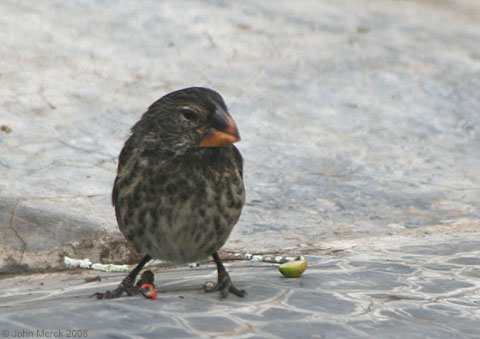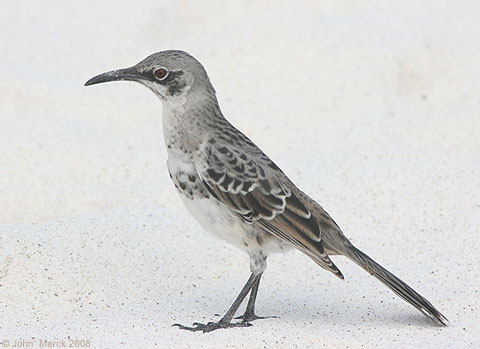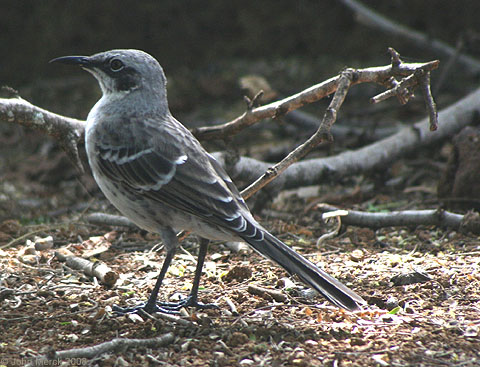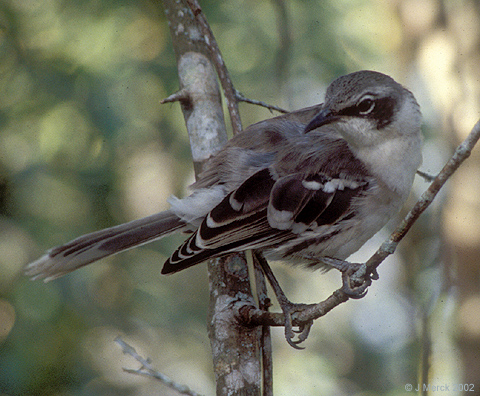GEOL 331 Principles of Paleontology
Fall Semester 2008
Evolution Review
Evolution: Descent with Modification
Intellectual background to Darwinian Evolution:
- Uniformitarianism - Ancient Earth
- Extinction
- Early eovlution
- George-Louis Leclerc - Count of Buffon (1707-1788)
- Jean Baptiste Antoine de Monet, Chavalier de Lamarck (1744 - 1829)
- inheritance of acquired characters.
- orthogenesis
Career of Darwin:
The reality of the pattern of evolution.
Prior to the discovery of geological time, it was reasonable to assume that all organisms had appeared recently. Since there had not, it was thought, been enough time for organisms to accumulate a serious history, the idea that their form reflected their history was meaningless.
The discovery of geological time, however, added an extra dimension to the organization of organismal form. Specifically, when fossil and living organisms were organized according to their similarity of form and their occurance in time, it began to seem as if lineages had slowly been modified through time, and even as if different lineages had branched from the same ancestor. Indeed, as soon as geological was discovered, biologists began speculating that species had evolved, ie, has been modified during their descent. Even biologists like Louis Agassiz, who openly rejected evolution couldn't help but organize the history of organisms in a suggestive way.

The pattern of evolution was readily visible to many investigators by the early 19th cent. All it took was the recognition of geological time, and some familiarity with the fossil record. The problem was that no one could propose a convincing mechanism by which this might happen. Several people tried, but were unable to propose anything that did not at some point resort to unfalsifiable propositions.
Jean Baptiste Lamarck, who proposed that:
- "driving forces of nature" impelled organisms toward "improvement".
- diversity generated through the inheritance of acquired
- Orthogenesis Lineages were created at various times and passed through a set series of "improvements." The reason we see such a diversity of organisms is that the products of different creations are in different evolutionary stages.
Indeed, Richard Owen's Dinosauria was intended as a refutation of Lamarck. His reptiles were bigger and more like modern mammals and birds in the distant past than reptiles today. Hardly a case for improvement.
Problem: the driving force was unmeasurable (indeed, there was no physical evidence to suggest that it existed) , and the definition of "improvement" was subjective. Nevertheless, people were searching, and the stage was set for a major intellectual revolution. It was a matter of time before someone put it all together.
|

|
More
How it happened: Enter Charles Darwin (1809-1882)
Darwin received a strong religious upbringing and was slated first for a medical, then for a church career, however his real interests lay in natural sciences. In 1839 he obtained an unusual job: "Captain's companion" for the captain of the naval research vessel HMS Beagle. (Not a standard position. Capt. Robert FitzRoy, himself a capable naturalist, had a tendency toward severe depression which was made worse by the isolation of life at sea. To make life more pleasant, he hired Darwin to simply be his confidante) Darwin took advantage of the opportunity to become a proper naturalist. His three year voyage around the world changed his life and set the stage for his later career.
(cf. The Voyage of the Beagle, Charles Darwin for a highly readable account).
Before departure, Darwin purchased volume I of The Principles of Geology by Charles Lyell (a student of James Hutton). This book advanced Hutton's idea of uniformitarianism, i.e. that the geological processes that we observe today are the same ones that have been active in the past ("The present is key to the past"). Darwin read it on the way to South America. There, he encountered the fossils of ancient unknown mammals. By the time the Beagle reached the Galápagos Islands, Darwin seems to have been thinking about uniformitarianism in a biological context. On the Galápagos, (Geologically young volcanic islands) he noted paradoxes:
|

|
Each island seemed to have its own unique species of particular types of animals, including tortoises, finches, and prickly-pear cacti (although all were very similar). Darwin particularly focused on mockingbirds. Some examples:
Birds that had lifestyles very similar to those of England were physically dissimilar. For example:
- Galápagos large ground finches and Eurasian bullfinches (not true finches) were heavy seed crackers.
 ...
...
- Galápagos woodpecker finches and Eurasian woodpeckers probed in bark for insect larvae
 ...
...
.
More
|
Back in England, Darwin encountered the ideas of Thomas Malthus on reproductive excess. Malthus hypothesized that generally human populations left unchecked increased exponentially while the resource base on which they depended increased linearly.
What resulted was not a stable situation and one had only to look at human history to see how cruelly these two accounts were balanced. Of course, what was true for humans might also be true in nature.
No one knows when the lightbulb appeared above Darwin's head, but by 1842, he had begun a notebook on the "transmutation of species". And yet, for 24 years after the voyage, he kept the idea to himself.
He was not idle during this time. Note also that Darwin wasn't an intellectual lightweight. Had he never published on evolution, he would have made it into the history books on the basis of his work on marine biology and the geology of coral atolls.
Darwin, seems to have wanted to publish a large work on evolution late in life, to be his "crowning achievement". Problem: I said before that the evolutionary intellectual revolution was waiting for someone to connect the dots. If Darwin wouldn't do it, someone else would.
|

|
More
|
In fact, in 1858, Alfred Russel Wallace, a naturalist stationed in Indonesia, wrote to Darwin, asking his opinion of some new ideas that he had. Darwin was alarmed to see that Wallace had independently reached the same conclusions he had about evolution. The two agreed to co-author a small paper in 1858.
In 1859, Darwin hastily published The Origin of Species by Means of Natural Selection, or the Preservation of favored Races in the Struggle for Survival. (AKA The Origin of Species). First edition sold out first day.
|

|
More
|
In the Origin, Darwin advanced three concepts.
- Individual variation
- Hyperfecundity
- Natural selection.
These were illuminated by a large volume of observations.
|


|
More
Hyperfecundity
- Darwin discussed the ideas of Malthus, which imply that by necessity not all offspring will survive to reproduce. Given this fact, are we to think that this weeding out process will be random?
Natural selection
- Darwin says, "no", and introduces the term natural selection, which he defines as, "... the preservation of favorable variation and destruction of unfavorable variation..". It is analogous to the familiar 19th Century term artificial selection. Individuals that are better able to grow up and reproduce will, on average, pass their genes to the next generation preferentially. Natural selection is the mechanism which accounts for the observed pattern of evolution that had first gotten transmutationists thinking.
|

|
More
Darwin's three major contributions:
- A plausible set of encompassing rules by which evolution operated, ie a Theory of Evolution in the scientific sense of the word "theory."
- The rules were based entirely on measurable testable processes, not metaphysics.
- An acknowledgment of the primacy of differential reproduction as opposed to simple survival in the savage conditions of nature (Although he occasionally gave in to the Victorian fashion to express his concepts in terms of a "struggle for survival").
By the time of his death (1882), the academic community had largely been won over.
Problem:
- There was one link in the logical chain that Darwin was unable to forge: He never could identify the generator individual variation or describe the laws of inheritance of characters. He speculated on some possibilities, but these proved unsatisfactory. Of course, no one was going to argue with the reality of the phenomenon.
- In fact, the answer to this problem was published in 1865 by Gregor Mendel, a Czech. Mendel is considered the founder of the science of genetics, which deals with the laws of inheritance.
- The sad irony: Darwin spent the last 23 years of his life groping for the answer that Mendel had arrived at. When he died, an unopened reprint of Mendel's publication was found in his desk. Thus, the synergy of of evolution and genetics had to wait two generations until the early 20th century New Synthesis.
|

|
More
OUR problem: Every few months, one hears something like this from a prominent politician, journalist, or cultural figure:
"Well, it is a theory. It is a scientific theory only, and it has in recent years been challenged in the world of science -- that is,
not believed in the scientific community to be as infallible as it once was." - Ronald Reagan, 1980
Is it true, or have they naively misinterpreted advances in science? Let's see.
Other mechanisms of evolution: Mendel's work on genetics was rediscovered by the scientific community in 1900. When this occurred,
biologists began synthesizing the fields of genetics and evolution in a movement called the New Synthesis. In this synthesis,
several other evolutionary processes that work independently and in parallel to natural selection were discovered.
- Genetic drift. Evolution (descent with modification) can occur as a result of purely random events. Cf. that every individual
has a unique combination of genes. When an individual is added to or removed from the gene pool, that gene pool is changed. In large
populations, the effect is negligible, but in small populations, the addition or removal of an individual has noticeable effects. Consider
the prevalence of brachydactyly among the Amish. This gene was brought to the
community by a single member of the founding population but because the Amish population is small and members generally marry within their
group, it has, by chance proliferated.
- Genetic linkage: The evolutionary interactions of genes that are close together on a chromosome. Remember
meiosis, the process by which gametes
(reproductive cells) are created:
- Nuclear DNA coalesces into chromosomes. These line up in homologous pair, each of which contain alleles, variants
of equivalent genes.
- Crossing over: Chromosomes are fragile and tend to break, however the repair mechanisms of the cell relentlessly repair them.
When homologous pair are lined up, however, they tend to become intertwined and break. The cell may then inadvertently mismatch the parts
during repair. The result is that the information in homologous chromosome pairs is constantly being recombined.
- Meiosis: Normal body cells are diploid - that is, they contain two a full compliment of chromosomes and two alleles of
every gene. Gametes are haploid. They contain half the normal compliment and only one allele of each gene. This happens because
during meiosis, homologous chromosome pairs are separated into separate gametes.
Thus, genetic information gets shuffled during both meiosis and crossing over. Note, however that:
- During crossing over, genes that are close to one another on the same chromosome are more likely to travel together than ones that are far apart.
- During meiosis, genes on the same chromosome are more likely to travel together.
Suppose that a particular gene is highly favored by natural selection. Genes with no particular selective advantage that are close to it on
the same chromosome are likely to be favored simply because they are fellow-travelers of the selectively favored gene. This "genetic
parasitism" is termed genetic linkage. An example in humans is the linkage of
nail-patella syndrome (a condition causing abnormalities of the
limbs and kidney disease) and type-B blood.
- Sexual selection: Really a subset of natural selection - evolution based on the selective advantage of traits that
improve reproductive success, even if otherwise deleterious.
Genetic linkage sometimes manifests itself during sexual selection. Suppose there were a human population in which females possessed
a gene that cause a compulsion to mate with men with red hair? Clearly we would get a general shift across generations toward a kind of genetic linkage:
- Red hair in both their male and female offspring (even though females would be indifferent to female redheads).
- Prevalence of the "female red-hair mating preference" gene in both their male and female offspring (even though it would not be expressed in males).
And, any individual passing on one gene would likely pass on the other. This particular concatenation of genes can lead to "runaway sexual selection" in
which bizarre and otherwise maladaptive structures and behaviors evolve.
Mate selection choice is usually exercised by the limiting gender - whichever gender is the limiting factor for reproduction. In vertebrates this is usually the female. In some species, however, the opposite is true. examples:
- Emus, for example, females mate then abandon their eggs in a nest. The male, alone, guards the eggs and raises the chicks. For this reason, the male emu is the limiting gender and during mating season, females display flambouyantly to the males.
- Topis. Females synchronize ovulation to occur during a short mating season in which a given female can only be impregnated over one or two days. Females fight over the studliest males who can only do so much over a short time span.
- Sea horses. Females place eggs in the male's pouch, where they are fertilized and "gestated."
- Pleiotropy: When a single gene has many independent phenotypic manifestations. Not surprising. Genes code for proteins, and a
protein may interact differently with different tissues. A recent example in the news involves the linkage of
iris shape and personality through the action of the PAX6 gene. Even if one
phenotypic effect of a gene is neutral or slightly deleterious, it may be selected for if another is highly advantageous.
- Heterchrony: Subtle changes over evolutionary time in an organism's developmental timetable are a potent source of overall evolutionary change, as discussed previously.
There is no doubt about the reality of any of these mechanisms. The only thing that is debated is theri relative importance at different times.
To Syllabus.
Last modified: 22 August 2008







 ...
...
 ...
...




